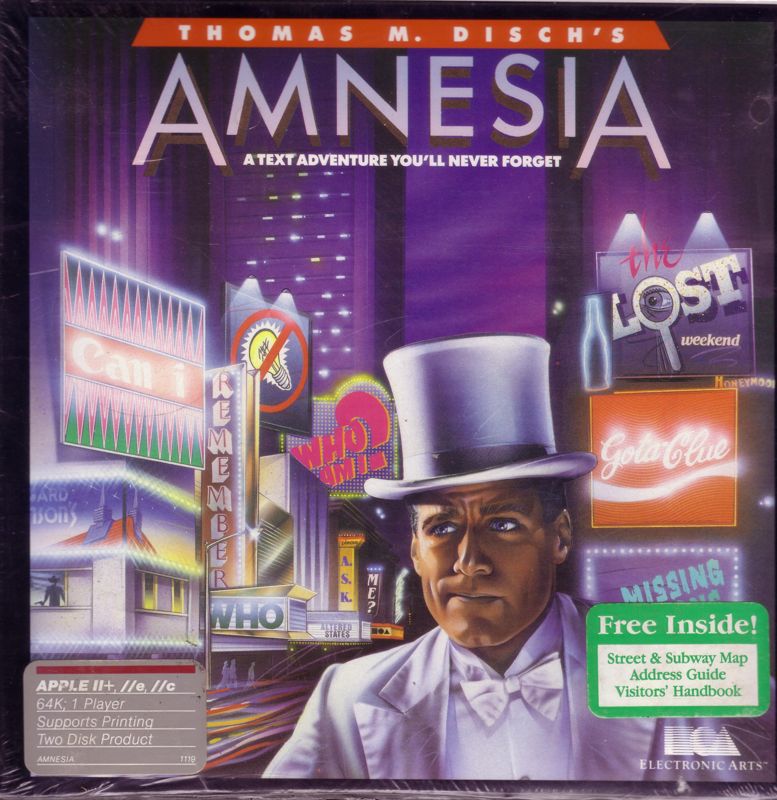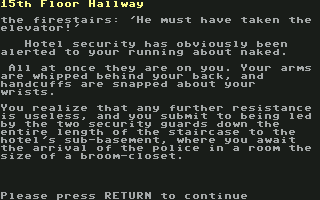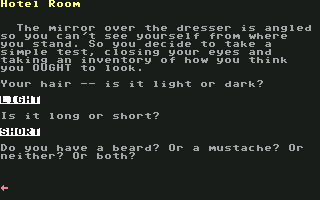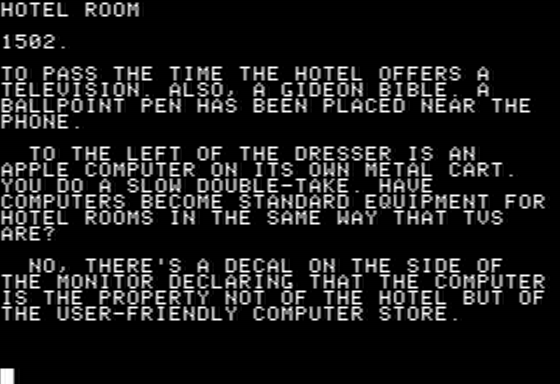Retro Replay Review
Gameplay
Amnesia greets you with a bold premise: you awaken naked and penniless in a Midtown Manhattan hotel room, your memory wiped clean. From the first moment, the game thrusts you into a thrilling game of cat-and-mouse, as you learn not only that someone is trying to kill you but that you’re also wanted for murder in Texas. This immediate sense of urgency sets the tone for a gameplay loop that blends exploration, puzzle-solving, and survival mechanics in one sprawling urban playground.
(HEY YOU!! We hope you enjoy! We try not to run ads. So basically, this is a very expensive hobby running this site. Please consider joining us for updates, forums, and more. Network w/ us to make some cash or friends while retro gaming, and you can win some free retro games for posting. Okay, carry on 👍)
The heart of Amnesia’s gameplay lies in its meticulous reproduction of Manhattan. With some 4,000 individual locations, 650 streets, and a full subway system, you’ll need more than intuition to find your way—you’ll rely on the included paper map and the ingenious “X-Street Indexer” code wheel. Align avenue names with street numbers to pinpoint intersections, or get hopelessly lost in a boroughscape that feels vast and alive. This analog navigation system may feel old-school, but it lends an immersive tactile element that modern downloads often lack.
Beyond exploration, Amnesia’s puzzles demand a keen sense of timing and resource management. Stores open and close according to the simulated time of day, so you’ll plan your errands, conversations, and investigations around business hours. Inventory-based challenges and dialogue trees with New Yorkers feature prominently, requiring you to be in the right place at the right hour. Meanwhile, the threat of starvation and exposure forces you to take odd jobs, scrounge for food, and secure shelter each night, blending detective work with genuine survival stakes.
Graphics
By contemporary standards, Amnesia’s visuals are simplicity itself—relying on text descriptions, rudimentary illustrations, and that indispensable paper map. Yet this old-school presentation has its own charm: the imagination fills in the gritty details of late-night alleys, crowded subways, and neon-lit avenues. Far from a drawback, the minimalism encourages you to project your fears and expectations onto the blank canvas of midtown Manhattan.
Where Amnesia truly shines is in its environmental storytelling. Although you won’t find flashy 3D models or dynamic lighting, the game’s text and occasional static images conjure a convincing cityscape. A locked-up deli at dusk, the echo of footsteps in a deserted subway tunnel, a chirpy street vendor at dawn—all these scenes come alive through vivid prose. The urban ambiance, recreated with words and mood-setting artwork, resonates longer than many pixel-perfect titles of its era.
The code wheel and printed street indexer might seem quaint, but they double as tactile graphics—tools you physically handle while charting your course. In an era before fully integrated in-game maps, this analog approach offers a sense of discovery and mastery that few digital overlays can replicate. The act of spinning a wheel to locate the nearest cross street becomes a gameplay moment in itself, heightening your immersion in the city’s labyrinthine grid.
Story
At its core, Amnesia is a captivating tale of identity, conspiracy, and redemption. Stripped of memory, our protagonist scrambles to piece together who he is and why someone wants him dead. Each fragment of dialogue, every torn newspaper clipping, and every shady informant you encounter adds layers to a mystery that spans the city and reaches all the way to Texas. The narrative’s pacing is masterfully handled, with revelations timed to keep you on edge.
The people of Manhattan are both your allies and your enigmas. Through conversation-based puzzles, you probe saloon keepers, cabbies, and corporate insiders for clues. Your “character” score reflects how you interact—are you polite, coercive, or charming? These choices subtly alter the story’s texture, making dialogue feel consequential rather than rote. By the time you confront the murder mystery at the heart of the plot, you’ll feel invested in every face and corner of the city.
Balancing the murder investigation with personal survival creates a compelling tension. You’re not merely a detective on a chase; you’re also a man fighting hunger, exhaustion, and the cold. The three-part scoring system—detective, character, and survivor—reinforces that duality. Progress the plot at your own risk, but neglect your basic needs and you’ll pay a harsh penalty. This narrative-simulation blend ensures that every choice, from asking for directions to skipping meals, shapes both your story and your fate.
Overall Experience
Amnesia offers a uniquely immersive journey through the streets of 1980s Manhattan. Its analog navigation tools, time-based economy, and layered scoring system combine to create a gameplay experience that’s as much about living the life of an amnesiac fugitive as it is about solving a murder. The sense of scale and authenticity is truly remarkable for a title of its era.
Players seeking quick action or flashy visuals may find the pacing deliberate, but those willing to invest in the world-building will discover a supremely rewarding adventure. The requirement to study maps, hustle for money, forge relationships, and juggle survival adds genuine stakes to every street corner and subway car. Few games blend detective work and day-to-day struggle so seamlessly.
Ultimately, Amnesia stands as a testament to the power of imaginative design over technical spectacle. It challenges you not only to unravel a tangled conspiracy but to navigate the real demands of an unforgiving city. For players intrigued by exploration-heavy storytelling, emergent puzzles, and robust survival simulation, Amnesia remains an unforgettable classic—one that continues to inspire modern urban adventures.
 Retro Replay Retro Replay gaming reviews, news, emulation, geek stuff and more!
Retro Replay Retro Replay gaming reviews, news, emulation, geek stuff and more!









Reviews
There are no reviews yet.